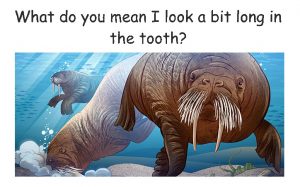You look a bit ‘long in the tooth’!
Typically, If you describe someone as being ‘long in the tooth’, you are saying derisively or humorously that they are old or aging.
However, there may be more at stake than hurt feelings.
Clinically speaking, having an unusually long tooth or teeth can be symptomatic of a much bigger problem. Gum disease.
My Tooth Became Really Big. Can You Help Me?
I saw this new patient last week, and she was correct. When you looked at her, all that you saw was one tooth. I don’t mean that one tooth was all that was present. She has many teeth that show when she smiles and talks. What I am referring to is one tooth that stands out more prominently than all of those around it. She was literally ‘long in the tooth’.
How did it stand out? First of all, it was much longer than the teeth on either side. It was her cuspid, or “eye tooth” as people commonly refer to it. The tooth is a large tooth, to begin with, but this was even larger and more prominent than we usually see.
The tooth was also pushed forward. When a front tooth is pushed forward, two things can result. First of all, the tooth may bite on the lower lip and therefore feel strange. It also causes a protrusion of the upper lip.
To top off these calls to attention by the tooth, the color of this tooth was whiter than the rest.
Gum Disease Spreading to the Bone
I recently wrote about shorter teeth.
Shorter teeth come as the result of years and decades of wear of the biting surface as we get older.
I also mentioned some teeth could do just the opposite. They appear to get longer as the gum and bone shrink a little away from the tooth.
My new patient was not an example of either scenario. Her tooth got much “longer” because of gum disease.
Gum disease starts in the gums and then spreads to the bone. This condition is a bacterial infection that will destroy the bone in which the tooth rests. If the disease damages all of the bone, then the tooth will become loose.
If you are lucky enough, you won’t experience any pain, and one day, the tooth will fall out of your head.
More likely than not, you will have swelling and discomfort requiring help from a professional to either save the tooth or remove it, depending on the severity of the situation.
A Good Analogy
Once the bone is attacked and slowly is destroyed, the tooth loses its primary stability.
Let me give you an analogy.
Think of a post implanted in the ground.
If the earth is covering a good portion of the post, then the post remains stable.
If the ground erodes away from the post and more post is above the surface than in the earth, instability will appear. The post will become movable, and if pressure is applied, it will no longer stand perfectly straight. It will start to lean to one side or the other.
The same thing happens to a tooth with gum disease, and this is what I saw in the mouth in question. Fortunately for her, the bone destruction did not extend significantly to the adjacent teeth. I recommended removing the tooth and replacing it.
As for the fact that this tooth was also whiter than the rest is because she had an old crown on the tooth. That crown matched her teeth years ago and was thus whiter.
No matter how I replace the tooth, I would correct the color and make it match its neighbors.
Building Bridges
So how did I plan on replacing the tooth after removal?
Our choices were either a single implant or a permanent bridge which can’t come out.
After an evaluation, I recommended a bridge for two main reasons.
-
The first reason centers on the fact that the bone loss was resulting in the bone moving upwards. If I placed an implant, the resultant tooth would be very long.
Remember that was one of her initial concerns. A permanent bridge would deal with this long tooth issue better.
- Secondly, I would utilize my “Same Day-Immediate Bridge” technique that I developed. It allows me to remove a tooth and provide a replacement in usually less than an hour. We did that, and she left with a stunning and much-improved smile.
Taking Advantage of Our “Better Than Insurance” Program
Best of all, she took advantage of our “Better than Insurance” program that I mentioned in the last couple of columns. Rules do apply, but she met all of the criteria and saved 20% of the fee.
She looked terrific, and we saved her money! Another happy customer and a healthy smile!
Call Megan today at 440.951.7856 and find out about our “Better Than Insurance” initiative to save you money and preserve your smile for a lifetime.
Jeffrey Gross, DDS, FAGD is an Ohio licensed general dentist and is on the staff of Case Western Reserve School of Dental Medicine.

